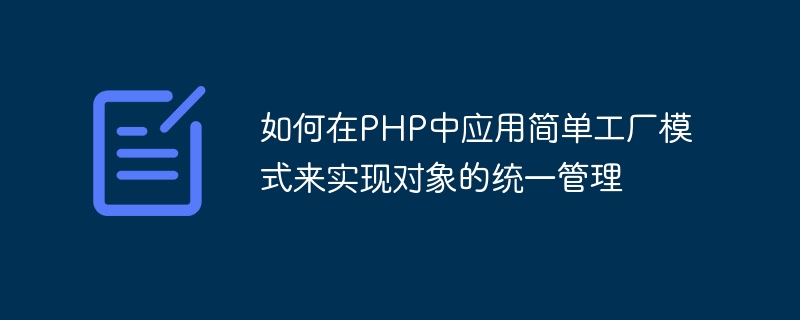 Backend Development
Backend Development
 PHP Tutorial
PHP Tutorial
 How to apply the simple factory pattern in PHP to achieve unified management of objects
How to apply the simple factory pattern in PHP to achieve unified management of objects
How to apply the simple factory pattern in PHP to achieve unified management of objects

How to apply the simple factory pattern in PHP to achieve unified management of objects
The simple factory pattern is one of the design patterns, which produces products through a factory class Objects of different types, and the client only needs to call the method of the factory class to obtain the required object, thereby avoiding direct coupling with the class of the specific object.
In PHP, we can use the simple factory pattern to achieve unified management of objects. The following is a sample code:
// 抽象类
abstract class Animal {
public abstract function sound();
}
// 动物类实现
class Dog extends Animal {
public function sound() {
echo "汪汪汪";
}
}
class Cat extends Animal {
public function sound() {
echo "喵喵喵";
}
}
// 简单工厂类
class AnimalFactory {
public static function createAnimal($type) {
switch ($type) {
case 'dog':
return new Dog();
case 'cat':
return new Cat();
default:
throw new Exception("Unsupported animal type: " . $type);
}
}
}
// 客户端使用示例
$dog = AnimalFactory::createAnimal('dog');
$dog->sound(); // 输出:汪汪汪
$cat = AnimalFactory::createAnimal('cat');
$cat->sound(); // 输出:喵喵喵In the above example, we first define an abstract classAnimal, and created two specific animal classes Dog and Cat, both of which implement the sound method.
Then, we created a simple factory class AnimalFactory, which has a static method createAnimal, which creates different types of animal objects by passing in different parameters.
Finally, in the client code, we can directly call the method of the factory class to obtain the animal object, and use the object's method to operate.
By using the simple factory pattern, we achieve unified management of objects, and the client is decoupled from specific animal classes.
The simple factory pattern has great flexibility in actual development. We can add new animal classes at any time without modifying the client code. This design also facilitates code maintenance and expansion.
In short, the simple factory pattern is an effective way to achieve unified management of objects. By decoupling the creation and use of objects, we can effectively improve the maintainability and scalability of the code.
The above is the detailed content of How to apply the simple factory pattern in PHP to achieve unified management of objects. For more information, please follow other related articles on the PHP Chinese website!

Hot AI Tools

Undresser.AI Undress
AI-powered app for creating realistic nude photos

AI Clothes Remover
Online AI tool for removing clothes from photos.

Undress AI Tool
Undress images for free

Clothoff.io
AI clothes remover

AI Hentai Generator
Generate AI Hentai for free.

Hot Article

Hot Tools

Notepad++7.3.1
Easy-to-use and free code editor

SublimeText3 Chinese version
Chinese version, very easy to use

Zend Studio 13.0.1
Powerful PHP integrated development environment

Dreamweaver CS6
Visual web development tools

SublimeText3 Mac version
God-level code editing software (SublimeText3)

Hot Topics
 CakePHP Project Configuration
Sep 10, 2024 pm 05:25 PM
CakePHP Project Configuration
Sep 10, 2024 pm 05:25 PM
In this chapter, we will understand the Environment Variables, General Configuration, Database Configuration and Email Configuration in CakePHP.
 PHP 8.4 Installation and Upgrade guide for Ubuntu and Debian
Dec 24, 2024 pm 04:42 PM
PHP 8.4 Installation and Upgrade guide for Ubuntu and Debian
Dec 24, 2024 pm 04:42 PM
PHP 8.4 brings several new features, security improvements, and performance improvements with healthy amounts of feature deprecations and removals. This guide explains how to install PHP 8.4 or upgrade to PHP 8.4 on Ubuntu, Debian, or their derivati
 CakePHP Date and Time
Sep 10, 2024 pm 05:27 PM
CakePHP Date and Time
Sep 10, 2024 pm 05:27 PM
To work with date and time in cakephp4, we are going to make use of the available FrozenTime class.
 CakePHP File upload
Sep 10, 2024 pm 05:27 PM
CakePHP File upload
Sep 10, 2024 pm 05:27 PM
To work on file upload we are going to use the form helper. Here, is an example for file upload.
 CakePHP Routing
Sep 10, 2024 pm 05:25 PM
CakePHP Routing
Sep 10, 2024 pm 05:25 PM
In this chapter, we are going to learn the following topics related to routing ?
 Discuss CakePHP
Sep 10, 2024 pm 05:28 PM
Discuss CakePHP
Sep 10, 2024 pm 05:28 PM
CakePHP is an open-source framework for PHP. It is intended to make developing, deploying and maintaining applications much easier. CakePHP is based on a MVC-like architecture that is both powerful and easy to grasp. Models, Views, and Controllers gu
 How To Set Up Visual Studio Code (VS Code) for PHP Development
Dec 20, 2024 am 11:31 AM
How To Set Up Visual Studio Code (VS Code) for PHP Development
Dec 20, 2024 am 11:31 AM
Visual Studio Code, also known as VS Code, is a free source code editor — or integrated development environment (IDE) — available for all major operating systems. With a large collection of extensions for many programming languages, VS Code can be c
 CakePHP Creating Validators
Sep 10, 2024 pm 05:26 PM
CakePHP Creating Validators
Sep 10, 2024 pm 05:26 PM
Validator can be created by adding the following two lines in the controller.





